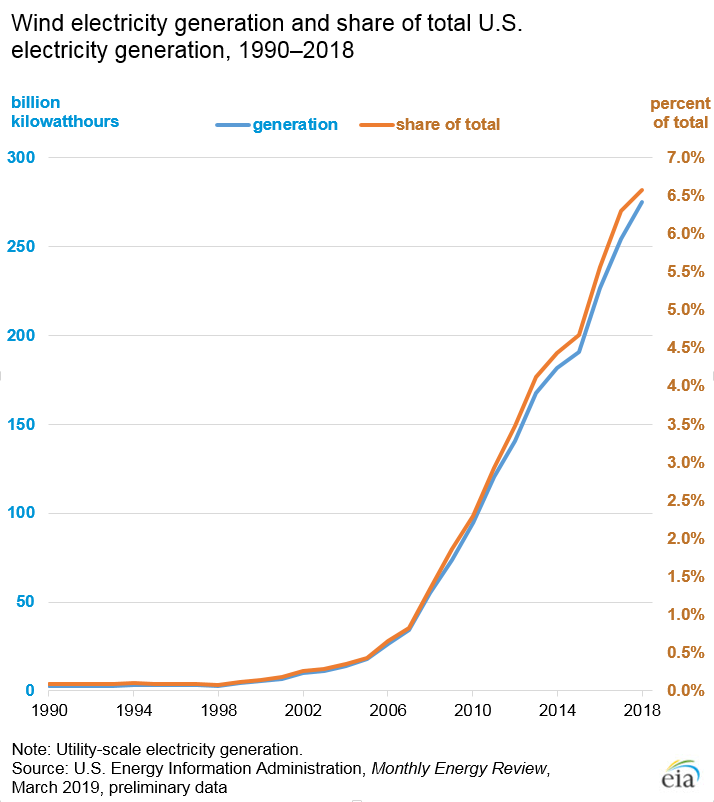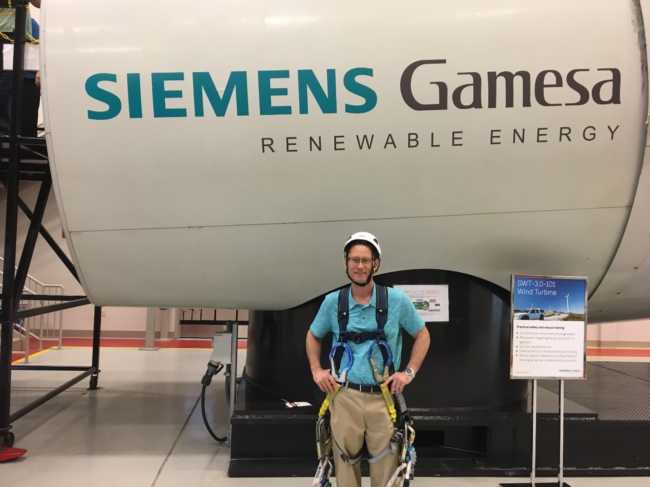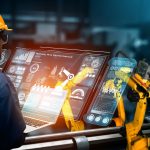The Tradewinds are Blowing, and Siemens Gamesa is Poised to Fill Their Sheets
Whether you are an advocate for distributed power generation, renewables, or simply a fan of technology and free power sources, there is no denying that wind power represents an opportunity to enhance power generation while maintaining carbon neutrality. It is no wonder that the number of wind turbine installations is increasing across North America. In fact, according to Acadia Power, “every state in the United States has either an operational wind energy project, a wind-related manufacturing facility, or both. Over 1,000 utility-scale wind projects with a total of 74,472 megawatts (MW) and over 52,000 wind turbines have been installed across 40 U.S. states and Puerto Rico. There are more than 500 wind manufacturing facilities across 43 states.”

Currently wind represents just over 6.5% of the share of total U.S. electricity generation. Further, it has increased as a percentage at a growing rate for the better part of the last two decades. Bearing this in mind wind represents an increasing portion of the total energy generated in the U.S.
Looking beyond political positioning and agendas, from a business standpoint, wind energy is projected to further expand as a percentage of energy production globally, and several organizations are poised to take advantage of this situation.
I had the opportunity to visit the Siemens Gamesa Wind Service Training Center in Orlando, Florida to discover how Siemens Gamesa is preparing the workforce to safely operate and maintain their wind turbines. Siemens Gamesa is arguably one of the leaders in wind turbine technology and according to BizVibe, “Siemens Gamesa, the latest merger between Siemens Wind Power and Gamesa, ranked second in the world’s top 10 wind turbine manufacturers list in 2018, primarily due to its strong position in the offshore sector in India and improved position in the United States.”

The $7 million Orlando Facility, built in 2013 by Siemens, is the company’s North American center for technical service and safety training for wind turbine technicians. The spacious site is also a venue leveraged by Siemens’ other businesses for professional development training. The Orlando campus is well designed to accommodate visitors. Every room has a number and color designation, which serves as a subconscious aid for navigating around the facility.
The Orlando site covers all aspects of turbine services for land-based Turbine installation and commissioning as well as servicing/maintenance. The third aspect of Siemens Gamesa’s Wind turbine offering, Offshore, is delivered in their Denmark and U.K. facilities. The Orlando team is hopeful that once offshore wind farms are introduced to the U.S. market, this training will also be introduced into their programs. The safety training for incoming service technicians is comprised of a two-week program that incorporates sight safety techniques, first aid, emergency response and rescue techniques for extracting injured workers safely from the turbine tower, nacelle, and gearbox. Technicians are then back every 2 years for a refresher to ensure their training is current. These skills are paramount, as standard emergency response teams are not trained nor responsible, for rescuing workers from an incident at a turbine site, this responsibility lies in the hands of Siemens Gamesa.
The technical training is extensive. It incorporates months of electrical, mechanical, hydraulic and electronics topics that span commissioning, crane training, as well as heavy lift training. The maintenance aspects are broken down into a multilevel approach that offers increasing levels of qualification. Technicians start at a base technician level and can progress their skills further to incorporate certifications as a Maintenance Technician and further as a Troubleshooting Technician. Additional certifications can be obtained for Commissioning and Repair as well as Construction.

Justin Butler, Siemens Gamesa’s Technical Trainer, pointed out the test labs where students practiced their skills by putting together a hydraulic unit and then tying it into a control cabinet. He smiled as he pointed out that following that portion of the training, the students have a troubleshooting exercise where certain wires are missing from the system and they need to find the error and figure out how to fix the situation. The initial training program is followed by six months of on the job (OJT) training. During the OJT students will encounter various sizes and models of wind turbines. They will perform several maintenance tasks one of which is bearing greasing and bearing seal inspections or main shaft maintenance for the main shaft connecting the turbine blades, which rotates at ~11-22 RPM, to the gearbox, where the shaft is stepped up to 1200-2000 RPM. The Yaw gear system is used to rotate the tower as wind direction changes. There are various sensors and monitoring equipment such as wind vein anemometers and ultrasonic wind velocity measuring devices attached to outside the wind turbine. From an Industrial IOT perspective, the technicians also need to know the ins and outs of Siemens Gamesa equipment software and computer systems and how they interface with the fiber network connecting the turbines to Siemens Global IoT Network. The command center for all North American Turbine Operations, a room affectionately referred to as “The R.O.C” (Remote Operations Center) by employees, is also located at the Orlando facility. From this room the team has remote access and full autonomy to monitor analyze and control every Siemens Gamesa Wind Turbine currently in operation.
The R.O.C. is staffed by a team of 16 who work as technical advisors and operator assistants. The team is comprised of both Gamesa specific and Siemens specific tech support representatives. Justin pointed out that essentially anyone with a headset on was talking to technicians in the field who were troubleshooting a turbine. The team does not work a night shift, as Siemens Gamesa promotes a work life balance, but they do have 24-hour on-call coverage to address urgent issues.
The R.O.C. measures the amount of covered systems in terms of total energy produced and not the number of systems currently in service. Currently they are monitoring over 1.6GW of power. This represents 1000s of wind turbines across North America that are all connected to Siemens IIoT data network. The network offers global connectivity to every wind turbine that is currently deployed. The team at the R.O.C. does get called in on global issues at times to cross share knowledge, but they are not responsible for system monitoring outside N.A. under normal conditions.
Justin offered a recent example where a team in Brazil reached out to him to assist with troubleshooting a system. They accessed the global database to see who had experience with their issue, the R.O.C. contacted Justin who had this issue at his site, and reached out to him to aid in the resolution. When putting in brand new platforms that have not previously been encountered, having access to the global knowledge base provides tremendous value, saving time and money for Siemens Gamesa and their clients.
When I asked Justin specifically what was monitored, he responded, “Everything. It’s really quite amazing.” He went on to state everything from power curves to real time system performance, which of course can be compared against theoretical design. They can, document, determine, and remotely correct to ensure a turbine is performing optimally. In addition to turbine diagnostic data, the team can monitor variables such as wind speed and direction, as well as numerous other environmental conditions, to determine if the turbine is producing optimally, and if it is not, they can offer corrections to bring it to its highest potential.
In short, the Siemens Gamesa team essentially has a full digital twin of all designs which they can benchmark against remotely and globally.
When asked if augmented reality was being leveraged during the training, Justin stated not yet but they are anxious to incorporate Siemens technology in this area. He went on to state that they have all the drawings in 3D they just need to finish incorporating the technology into the curriculum and convert them fully into the 3D realm.
If you’re looking for a career that offers technology, adrenaline and digitalization and you don’t mind a little wind in your hair, you may want to look apply at siemens.com/career. They are seeking candidates looking for a hands-on career who have a passion for all things mechanical and electrical. If you have attended a wind school or possess a keen desire for adventure, renewables, or both, then that is a bonus and you may be exactly who they are seeking.
References:
- https://blog.arcadiapower.com/timeline-wind-power-u-s/
- https://www.bizvibe.com/blog/energy-and-fuels/top-10-wind-turbine-manufacturers-world/
- https://www.eia.gov/energyexplained/index.php?page=wind_electricity_generation
- https://www.siemensgamesa.com/en-int/products-and-services
This article was written by Greg Orloff, CBDO, IIoT World. The post is sponsored by Siemens USA.



